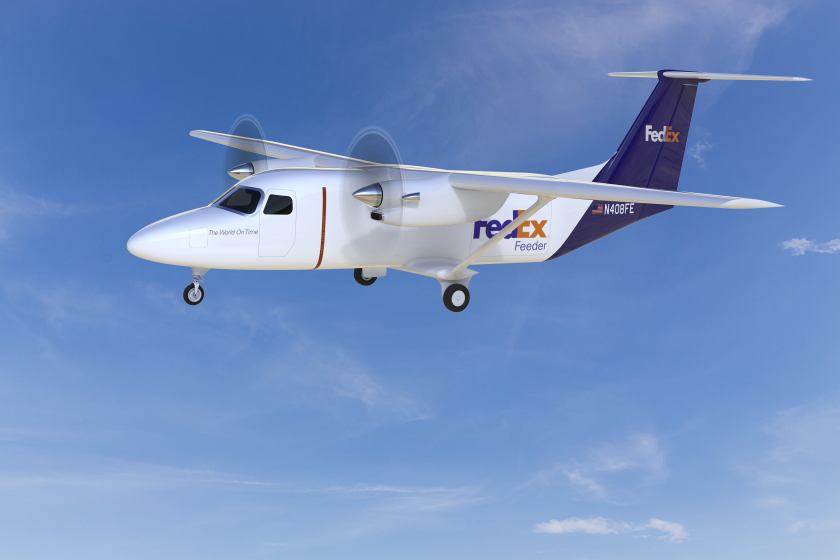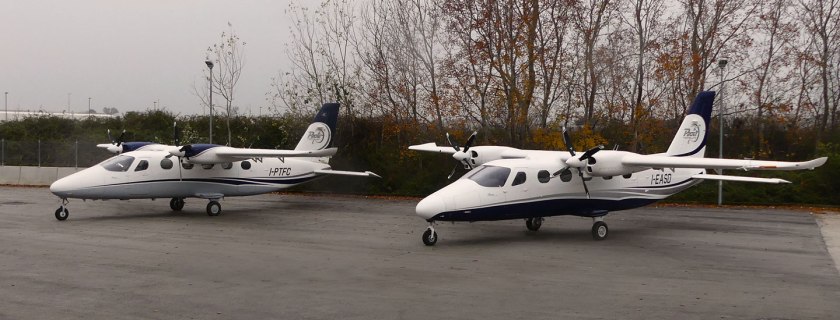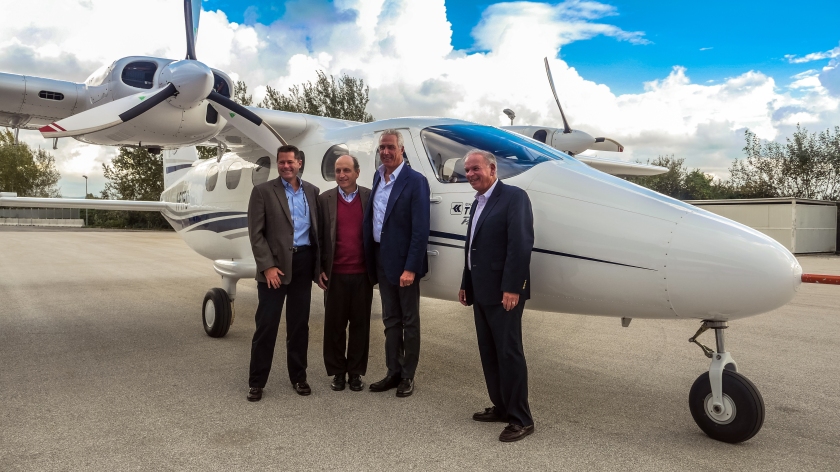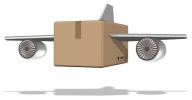By Kathryn B. Creedy
Nothing says commitment like a $275 million investment and that is exactly what FedEx signaled when it announced in November it was bankrolling a potential 100-aircraft order for Textron’s new Cessna SkyCourier 408. But the order is far more significant than just a new aircraft.

FedEx was also signaling a huge commitment to the continued development of its small community air service, a refreshing departure from what is happening in the rest of the regional industry in which small communities have been shunted aside since the mid 1990s. The situation worsened with the implementation of the 1500-hour rule which severed the pilot pipeline and forced more than 50 communities off the scheduled airline map and now threatens 200 more.
The order comes on the heels of the company’s 30-aircraft order for the ATR 72-600F aircraft with the option to purchase up to 20 more.
“The recent announcements by FedEx Express to purchase both the Cessna SkyCourier 408F and the ATR 72-600F demonstrate the importance of our Feeder network in connecting small communities to the global e-commerce economy,” said FedEx Express Vice President of Supplemental Air Operations Bill West. “Connecting small communities in today’s e-commerce world, where what you order online is expected to be delivered within a matter of days, is strategically significant to not only FedEx but to those communities themselves. We recognize the important role our regional air cargo carrier providers play in the ability for those communities to thrive so our investment is in more than just new planes.”
FedEx also working to help regional cargo carriers with one of its major issues. “FedEx Express is committed to creating innovative pathways to employment in the aviation industry,” added West. “The introduction of these advanced regional aircraft will generate new employment opportunities for people who are interested in becoming pilots or other aviation professionals.”
Both the cargo and the passenger models will be certified for single-pilot operation which could also help. “Some operators want to use it as a crew airplane so the co-pilot can log second-in-command time,” Textron’s Brad Thress, senior vice-president, engineering, told Skies. “We’re working on that.”
The ability for copilots to log SIC time is an issue on which RACCA has been working.
FedEx’s 50+50 order for the new, small cargoliner stunned the industry. First, it was under the radar since Spring 2017 when FedEx approached the manufacturer and, thus, it was a surprise. Second, it showed FedEx had seen what many entrepreneurs and I had seen for years – there is a growing demand for air service in small communities but a dearth of new aircraft at the small end of the market to meet that demand.
Big orders used to be a thing of the past
Excitement surrounding the SkyCourier 408 followed Cape Air’s 100-aircraft order for Tecnam’s P2012, which achieved its latest major milestone – its first flight – on December 22 when it took to the skies. Since then it has accumulated more than 250 hours. Delivery for the first 20 of the order is just over a year away. The significance of the Cape Air order was the fact that the regional industry has not seen an order this size in quite some time.

The regional cargo airline industry has longed been concerned about its aging fleet. RACCA always highlights the issue at its conference by providing solid guidance on how to cope. Cape Air identified a need to replace its fleet of Cessna 402 a decade ago and has been shepherding the P2012 along since its inception. In the meantime, airlines like Cape Air, Great Lakes and Kenmore Air have developed mini-manufacturing facilities to service small aircraft like the Twin Otter, Beech 1900 and the Cessna 402. So, it is very refreshing that the regional cargo and passenger industries have new aircraft in the offing.
Other new aircraft on the horizon include the Czech LET 410, the Polish Skytruck, China’s Harbin Y-12 and even Piper’s M600. The Viking Air Series 400 Twin Otter was featured during last year’s RACCA conference.
“I think there’s a lot of potential,” Thress told Skies. “I think the market there is as big, or bigger, than the freight version. When we look at the global fleet of Caravans in passenger-carrying operations, it’s pretty extensive, especially in Africa and Asia.”
The Wall Street Journal noted the order comes as air freight market is booming. This clearly makes regional cargo carriers of paramount importance in the freight triangle created by the retailer, cargo carrier and consumer. That is just how the economy is built now.
Rebuilding the commuter industry
Today’s new aircraft – the SkyCourier and P2012 – come at a time when innovative operators are taking a second look at all the communities abandoned by the economic changes within the airline industry – those that used to be the bread and butter of the regional airline industry but have been dropped because of rising costs and changes to mainline priorities in regional airline service.
Some in the regional industry have expressed interest in launching new, independent regionals to serve these abandoned and underserved markets but have bemoaned the fact there are no new aircraft. That can no longer be said with two new offerings coming to market designed specifically for small community air service.
While they may be unpressurized, so, too, is the Twin Otter which is growing in value, according to Winair, a Caribbean regional that wants to add to its fleet. And the Caravan is a much-used aircraft throughout the world as noted by Thress. There are also new regionals like Tropic Ocean Airways, offering both scheduled and charter operations, using the Caravan out of Fort Lauderdale. The Caravan is also the mainstay of the St. Barts Commuter fleet meaning even the rich appreciate its service albeit for a very short flight.
More importantly, the development of the SkyCourier and the P2012 signal that something is happening at the small end of the market and it is a good start.
Traditional regional manufacturers missed the boat
I have been harping at the likes of Embraer, Bombardier, Pratt & Whitney-Canada and GE about this end of the industry saying there is an opportunity there. No, was the universal response, the trend was for bigger aircraft despite a cap on that size courtesy of scope clauses. Indeed, the Embraer’s E2-175 and Mitsubishi’s MRJ are both too heavy for scope.
But others, from airline presidents to manufacturers saw that opportunity and the FedEx and Cape Air orders are a wake-up call. Turns out, I was talking to the wrong guys because there was a lot roiling beneath the surface in their business aviation divisions. Indeed, we cannot ignore the development at GE with its new Advanced Turboprop, which is powering another new Cessna product – the Denali – a single-engine turboprop.
Beyond freight, however, new business models developed to meet the need for intra-regional and intra-state service abandoned by the majors and their regional partners in the last 20 years.
Surf Air with its PC-12 and Wheels Up, flying the Beech King Air, are great examples even if they do not fit the mold of the commuter airlines in the post-deregulation period. While both are complementing their t-prop service with small jets with the Cessna Mustang and the Embraer Phenom 300, they, and others like them have attracted the attention of business aviation manufacturers now that Europe has reformed single-engine turboprop operating (SETOps) rules which provides even more opportunity at the small end of the market. Daher reported at the 2017 SETOps Conference in London it has seen rising demand for its TBM-900 as a result of the regulatory change. It is significant that Piper was also a sponsor of the conference along with Pratt & Whitney-Canada and Textron.
The development of the SkyCourier and Tecnam’s P2012 are significant for another reason. There has not been this much activity in the small end of the market since the mid-1980s when Saab, de Havilland, Shorts, ATR, Embraer and others spotted the opportunity presented by deregulation and began offering newly developed turboprops to meet the growing post-deregulation demand in the new regional airline industry.
Certainly, at the time, the business/general aviation industry – on which these budding airlines relied for the Piper Cherokee and Beech 99s – did not see the new market. Then again, it was in the middle of a boom and didn’t think it needed the business although it did ultimately develop the Beech 1900 and the Swearingen Metro. But the newly developed aircraft from abroad had something business aviation aircraft did not have – the ruggedness to perform 2,000 flight hours annually, far more than most business aviation aircraft ever achieve. So, it is a bit ironic that the business aviation manufacturers are in the mix.
The big thing about FedEx is its commitment to all things small
We already knew about FedEx’s commitment to the small package industry. Heck, it invented it. But now it has signaled its commitment to small communities and small aircraft.
“We worked closely with Textron Aviation to develop the Cessna SkyCourier 408, which includes several key features that will help us grow our business in small and medium-sized markets, especially in the air freight segment,” said FedEx Express President and CEO David Cunningham.
Those features include a twin-engine, high-wing turboprop, digital cockpit, a flat-floor cabin with built-in rollers and 87” by 69” top-hinged door equipped to handle up to three LD3 containers and pallet operations. The aircraft also has a 6,000-pound max payload.
FedEx’s feeder fleet, now pegged at 300 aircraft, under 60,000 pounds maximum gross take-off weight, serves smaller markets in 45 countries. Most of these feeder aircraft are owned by FedEx and are leased and operated by different third-party air carriers under their own operating certificates, according to the company.

“These aircraft purchases are part of our long-term feeder fleet strategy,” said FedEx Express Executive Vice President of Air Operations Greg Hall, during the ATR announcement. “That strategy will not only improve our fuel efficiency and fleet reliability, but thanks to a collaborative training program we are planning, will create a reliable pipeline of well-qualified pilot applicants for FedEx Express pilot jobs, leveraging the experience they will gain in our feeder system.”
The SkyCourier’s ambitious service entry in mid-2020, depends on the simplicity of the aircraft and the integration of proven technology throughout the aircraft and systems. If it meets its in-service target that would mean clean sheet to in service in an unheard of three years.
Unlike other modern aircraft, it has aluminum skin, fixed gear and manual flight controls. However, modern avionics – The Garmin G1000 NXi avionics suite – grace the cockpit. The simplicity befits the operation and means higher dispatch reliability. The SkyCourier will cruise up to 200 knots (KTAS) with a 900-nm range. Pratt & Whitney- Canada notches up another airframe for its venerable engine, in this case, the PT6A-65SC engines complete with a fully connected engine monitoring system.
Despite the industry’s many challenges, these are exciting times with a lot of opportunity on the horizon.


Great stuff!
Sent from my iPad
>
LikeLiked by 1 person